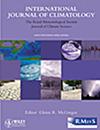Multi-Decadal Variations of Severe Cyclonic Storm Frequency Over the Bay of Bengal and Associated Mechanisms
Abstract
The present study explores the multi-decadal variability of Severe Cyclonic Storm (SCS) frequency over the Bay of Bengal (BoB) during post-monsoon season for the period 1950–2022. The SCS frequency displays noticeable decadal/multi-decadal variability during the study period, and shows a strong relationship with mid-tropospheric relative humidity (RH) and sea surface temperature (SST) over BoB. Influence of the large-scale climate modes, such as Atlantic Multi-decadal Oscillation (AMO) in modulating the BoB SCS frequency on multi-decadal time scale is highlighted. It is found that AMO exhibits a significant out-of-phase relationship with SCS decadal frequency over the BoB. Detailed analysis suggests that large-scale circulation changes associated with the negative phase of AMO (strong SCS decade) induced low-level convergence extending from western Indian Ocean to southern BoB favour increased SCS frequency. A negative AMO (strong SCS period) induced zonally oriented upper-level convergence and divergence centres, corroborated by the Walker circulation, helped to modulate the low-level circulation over BoB. High RH and warm SSTs associated with the negative AMO further supported the increased SCS frequency over BoB. In the case of weak SCS decade, positive AMO induced low-level divergence over southern BoB through atmospheric teleconnections provides unfavourable conditions for SCS formation. In addition to this, changes in the tropospheric temperature over the mid-latitudes caused by mid-latitude Rossby waves also contributed to the differences in SCS frequency on the multi-decadal time scale. This study highlights the role of AMO in modulating the multi-decadal SCS frequency over the BoB. The results presented here are useful for improving the decadal prediction of cyclone frequency over the BoB.


 求助内容:
求助内容: 应助结果提醒方式:
应助结果提醒方式:


